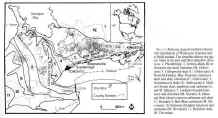Journal Of Sedimentary Research, Vol. B65, No.3(1995), 388-400
SEQUENCE ANALYSIS OF UPPER PLEISTOCENE (WISCONSINAN) GLACIOLACUSTRINE
DEPOSITS OF THE NORTHSHORE
BLUFFS OF LAKE ONTARIO, CANADA
I.P. MARTINI and M.E. BROOKFIELD
Department of Land Resource Science, University of Guelph, Guelph, Ontario
NlG 2Wl Canada
กก
 Up to 90 m of glaciolacustrine Upper Pleistocene (Wisconsinan) sediments are
well exposed along the north shore of Lake Ontario (Scarborough and Bowmanville
Bluffs), and contain critical information on the effects of glaciers on
sedimentation in large proglacial lakes, and on the deglaciation history of the
Great Lakes region of North America. The sediments vary greatly, but the overall
vertical trend is of a diamict unit at the base, changing upward into distal
clay-rich rhythmites, proximal sand-rich rhythmites, and well washed, deltaic
and/or coastal sands. In some areas, gravelly units are interbedded between the
basal diamict and the distal rhythmites; they are interpreted as subaqueous
outwash-fan de- posits. The glaciolacustrine sediments of these bluffs include
two different assemblages: one related to overland glaciofluvially derived
sediments ("lacustrine assemblage"), and another directly related to a
glacier with subaqueous terminus ("glacial assemblage"). The basic
concepts of sequence stratigraphy help in unraveling these complex deposits, if
conceptually adapted to accommodate the "glacial assemblage" where a
"stand" is not necessarily controlled by water level but rather by the
relative position of the sediment injection point in the basin. Thus, "lowstand"
(lowstand- equivalent systems tract) subaqueous outwash-fan deposits of the
"glacial assemblage" may form in ice-dammed lakes, while, at the same
time, "highstand" (highstand systems tract) facies of the "lacustrine
assemblage" are deposited in other parts the basin. Furthermore, as the
glacier retreats, subaqueous outwash deposits may be overlain abruptly by deep-
basin, clay-rich lacustrine rhythmites, locally forming a forced transgressive
facies sequence without any change in water level. Opening and closing of
outlets by the glacier also causes rapid changes in lake level, leading to
development of shelf-margin systems tracts and forced-regression systems tracts
for the "lacustrine assemblage".
Up to 90 m of glaciolacustrine Upper Pleistocene (Wisconsinan) sediments are
well exposed along the north shore of Lake Ontario (Scarborough and Bowmanville
Bluffs), and contain critical information on the effects of glaciers on
sedimentation in large proglacial lakes, and on the deglaciation history of the
Great Lakes region of North America. The sediments vary greatly, but the overall
vertical trend is of a diamict unit at the base, changing upward into distal
clay-rich rhythmites, proximal sand-rich rhythmites, and well washed, deltaic
and/or coastal sands. In some areas, gravelly units are interbedded between the
basal diamict and the distal rhythmites; they are interpreted as subaqueous
outwash-fan de- posits. The glaciolacustrine sediments of these bluffs include
two different assemblages: one related to overland glaciofluvially derived
sediments ("lacustrine assemblage"), and another directly related to a
glacier with subaqueous terminus ("glacial assemblage"). The basic
concepts of sequence stratigraphy help in unraveling these complex deposits, if
conceptually adapted to accommodate the "glacial assemblage" where a
"stand" is not necessarily controlled by water level but rather by the
relative position of the sediment injection point in the basin. Thus, "lowstand"
(lowstand- equivalent systems tract) subaqueous outwash-fan deposits of the
"glacial assemblage" may form in ice-dammed lakes, while, at the same
time, "highstand" (highstand systems tract) facies of the "lacustrine
assemblage" are deposited in other parts the basin. Furthermore, as the
glacier retreats, subaqueous outwash deposits may be overlain abruptly by deep-
basin, clay-rich lacustrine rhythmites, locally forming a forced transgressive
facies sequence without any change in water level. Opening and closing of
outlets by the glacier also causes rapid changes in lake level, leading to
development of shelf-margin systems tracts and forced-regression systems tracts
for the "lacustrine assemblage".